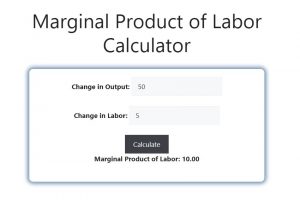About Marginal Product of Labor Calculator (Formula)
The Marginal Product of Labor (MPL) Calculator is a crucial tool for businesses and economists alike, enabling them to assess the additional output generated by adding one more unit of labor. Understanding MPL helps organizations optimize their workforce, allocate resources effectively, and make informed decisions about hiring. By calculating the MPL, businesses can identify the most productive use of their labor force, ultimately enhancing overall productivity and profitability.
Formula
The formula for calculating the Marginal Product of Labor is:
MPL = Change in Output / Change in Labor
This formula allows businesses to quantify how much additional output is produced when one more unit of labor is added.
How to Use
Using the Marginal Product of Labor Calculator is straightforward. Follow these steps:
- Identify Change in Output: Determine the difference in total output before and after adding labor. This could be measured in units produced, revenue generated, or any other relevant metric.
- Identify Change in Labor: Calculate the change in the number of labor units employed. This can include hiring new employees, increasing hours, or adjusting labor input.
- Input Values: Enter the change in output and change in labor into the calculator.
- Calculate MPL: Click the calculate button to determine the Marginal Product of Labor.
Example
Let’s illustrate the use of the Marginal Product of Labor Calculator with an example.
Example Data:
- Change in Output: 50 units
- Change in Labor: 5 workers
- Input Values:
- Change in Output = 50 units
- Change in Labor = 5 workers
- Calculate MPL: Using the formula: MPL = Change in Output / Change in Labor
MPL = 50 / 5
MPL = 10
In this example, the Marginal Product of Labor is 10 units, indicating that each additional worker contributes an average of 10 extra units of output.

FAQs
1. What is Marginal Product of Labor (MPL)?
Marginal Product of Labor (MPL) measures the additional output generated by adding one more unit of labor to the production process.
2. Why is MPL important for businesses?
Understanding MPL helps businesses optimize labor allocation, enhance productivity, and make informed hiring decisions.
3. How is MPL different from Total Product?
Total Product measures the overall output produced, while MPL focuses specifically on the additional output from one more unit of labor.
4. Can MPL be negative?
Yes, MPL can be negative if adding more labor leads to a decrease in overall productivity, often due to overcrowding or inefficiencies.
5. How do I interpret the MPL value?
A higher MPL indicates greater efficiency, meaning that each additional worker contributes significantly to output. Conversely, a lower MPL suggests diminishing returns.
6. What factors can affect MPL?
Factors such as technology, worker skill level, equipment, and production processes can all influence the Marginal Product of Labor.
7. Is MPL the same as Productivity?
While related, MPL specifically measures the change in output from additional labor, whereas productivity encompasses the overall efficiency of production.
8. How can I increase MPL?
To increase MPL, consider improving worker training, optimizing processes, upgrading technology, or enhancing working conditions.
9. How often should I calculate MPL?
Regularly calculating MPL, especially after significant changes in labor or production methods, helps track workforce efficiency over time.
10. Can MPL be calculated in non-manufacturing sectors?
Yes, MPL can be applied in various sectors, including services, agriculture, and technology, wherever labor input contributes to output.
11. What is the relationship between MPL and hiring decisions?
Analyzing MPL can inform hiring decisions by identifying the optimal number of workers needed to maximize output and minimize costs.
12. How do fixed costs influence MPL?
Fixed costs do not directly affect MPL calculations, but understanding overall costs is essential for evaluating profitability and resource allocation.
13. What is the law of diminishing returns in relation to MPL?
The law of diminishing returns states that as more units of labor are added, the incremental output gained from each additional unit may eventually decrease.
14. How does MPL relate to labor market trends?
Understanding MPL helps businesses adjust to labor market trends, such as supply and demand fluctuations, by aligning hiring strategies with productivity goals.
15. What is a good MPL value?
A good MPL value varies by industry; however, a higher MPL generally indicates a more productive workforce.
16. Can technology influence MPL?
Yes, technology can enhance MPL by increasing the efficiency of labor, thereby increasing output without a proportional increase in labor input.
17. How does MPL impact overall profitability?
By maximizing MPL, businesses can improve overall output, leading to higher sales and profits while optimizing labor costs.
18. Is MPL a static measure?
No, MPL is dynamic and can change over time with varying labor inputs, production methods, and external market factors.
19. How can I use MPL in strategic planning?
MPL can inform strategic planning by identifying labor needs, optimizing workforce composition, and enhancing overall productivity strategies.
20. Where can I find additional resources on MPL?
Various online resources, including academic papers, business articles, and economic textbooks, provide in-depth insights into Marginal Product of Labor and its applications.
Conclusion
The Marginal Product of Labor Calculator is a vital tool for businesses seeking to optimize their workforce and enhance productivity. By understanding and calculating MPL, organizations can make informed decisions about hiring, resource allocation, and operational efficiency. This metric not only aids in maximizing output but also contributes to overall business success. Regularly analyzing MPL allows companies to adapt to changing market conditions, ensuring they remain competitive and profitable in their respective industries.